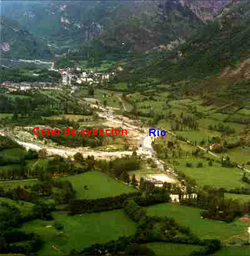Ejection cone
A dejection cone, also called cone or alluvial fan, is a form of fluvial modeling that is characterized in plan by having a conical or fan-shaped silhouette and a gentle slope (between 1 and 10 degrees, depending on the slope you are sliding down). This alluvial deposit is generated at the end of the torrential valleys, in the foothill areas, where the slope of the slopes connects with a flat area.
Its genesis is given by the loss of energy from rivers with a significant load of sediments, which are deposited by decreasing the slope along the alluvial fan. Their conical shape makes them act as a natural barrier in rivers, forcing them to divert their course and adapt to the relief. Its dimensions are variable and range from a few meters to hundreds of kilometers.
This type of morphology of the terrestrial relief is easily modified by a flood.
The sudden flooding of the flow of the Arás ravine in Biescas (Huesca, Spain) in 1996, which caused the flooding of a campsite and the death of 87 people, was due to the inappropriate location of said campsite in a dejection cone, in the natural course of the river.
Contenido relacionado
Historical geology
Armenian Geography
Greeks (Teruel)
